
The weightlifting guidelines for sciatica actually depend on the cause of pain.
You need not abandon strength training or muscle building altogether if you have sciatica.
“Before choosing which weightlifting exercises to do and which ones to avoid with sciatica, it’s important to determine why you’re having these symptoms,” says Dr. Tom Carpenter, corrective exercise specialist, certified personal trainer and chiropractor, inventor of Stand Corrected™, a portable harness-like stretching tool that helps alleviate back, neck and shoulder pain.
Lifting weights is not contraindicated by sciatica, but particular guidelines are in order before you jump into the gym.
“The sciatic nerve is a grouping of nerves from the lower back and sacrum that travel together through the buttocks and then down the back of the leg,” explains Dr. Carpenter.
“Sciatic symptoms can be caused for several different reasons.”
Causes of Sciatica Pain Include Cancer
Dr. Carpenter explains, “These nerves can be aggravated by a bulging or herniated lumbar disc; a space-occupying lesion such as a tumor; a narrowing of the spinal canal (known as stenosis); a congenital spinal deformity such as spondylolisthesis (a separation of the front and back portion of a vertebra), or simply an over-firing of the piriformis muscle.
“The piriformis muscle proximates the sciatic nerve and can compress it when it’s excessively tight, inflamed or in spasm.
“This has been called pseudo sciatica because its origin is not related directly to the spine.”
Dr. Carpenter continues, “Once you’ve been evaluated by your health care practitioner and determine the cause of your sciatica, you can then decide which exercises are and are not appropriate.”
An MRI is in order. This is the best way for the physician to determine the cause.
What kind of strength training can you do with sciatica?
Disc Problems
“If the sciatica is caused by a disc problem, for example, you would want to avoid exercises that will put excessive pressure on the disc, such as overhead press, deadlifts or any exercises that involve too much forward or backwards bending,” says Dr. Carpenter.
“Also, exercises involving the transverse plane (twisting) should be done conservatively.
“Instead, concentrate on core training such as planks, pikes and bridges.

Plank. Freepik

Pike (“downward dog”). Freepik/yanalya

Bridge. Freepik
“Weight training the arms and legs should not be a problem, but if the sciatic pain appears or worsens, stop immediately.”
Tight or Inflamed Piriformis
“If the pain is caused by a tight or inflamed piriformis, make sure to foam roll and stretch that area before and after training,” says Dr. Carpenter.
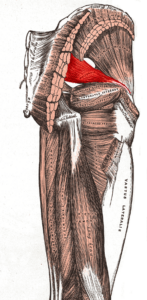
The piriformis muscle
“This condition is usually caused by overuse, which can cause it to become inflamed and swollen, which results in painful glutes. If it compresses the sciatic nerve, pain can then travel down the leg.
“After releasing the muscle(s) with the foam roll and stretches, place a circular resistance band around both legs above the knees and perform clam shells [below], then seated abductor exercises.
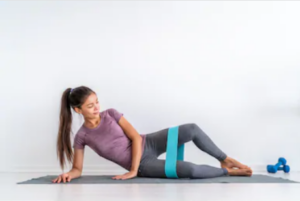
Shutterstock, Maridav
“Place a medicine ball between the legs while seated and do an isometric squeeze for 3-5 seconds.
“Next, on all fours, perform single leg back kicks, holding the isometric hip extension for two seconds.

Variation: one arm extended. Freepik.com/yanalya
“Follow this with two legged and then single legged bridges, again holding the isometric for two seconds.”

Freepik/Mangostar
Acceptable Strength Training Exercises for Sciatica Patients
You can do seated movements in which the back is supported in a way that discourages stress on the lower back or extending (backwards bending) the spinal column.
So instead of the standing or seated (on a bench) overhead press, you can use a shoulder press machine in which your back is up against a support pad.

Shutterbox/ CandyBox Images
Same thing with rowing movements: Use rowing equipment with a support pad for the chest, and keep your chest against the pad when pulling the handles towards you.
When doing biceps curls, use preacher equipment rather than standing, or sit against a support pad.

Shutterstock/BLACKDAY
What about squats? There are many varieties, but obviously, barbell squats are not a good choice for someone with sciatica, as these put a lot of load on the lumbar (lower back) region, especially if there’s bad form.
You may want to consider squats with a resistance band or a Smith machine (both below).
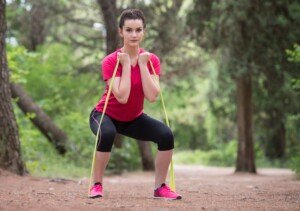
Shutterstock/Jasminko Ibrakovic
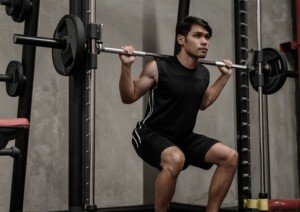
Shutterstock/Auttapol Sangsub
Dips should be safe to do, as these do not promote forward or backward bending of the spine.

Bar dips. Shutterstock/Syda Productions
Same with pull-ups and chin-ups, but be careful with pushups because some people allow their lower back to cave downward.
The bench press is also acceptable—as long as it’s done with good form (keep your back solidly on the bench, and ideally, keep your feet on the bench).
Lat pull-overs are also doable—with good form, of course. Do not yank down the bar or let it fly back up.
Additional Weightlifting Exercises that Are Safe with Sciatica
• Leg extension
• Horizontal leg press (legs at 90 degrees)
• Seated leg curl
• Dumbbell chest press on a bench
• Seated chest press
The use of tension bands as an alternative to free or machine weightlifting is another safe option for someone with sciatica.
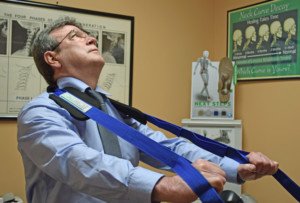
Photo credit: Aleesia Forni
Based upon 30+ years of experience, Dr. Carpenter’s practice approach reflects his belief that restoring optimum health and function will enable his patients to enjoy a much greater amount of vitality and wellness. Chiropractic care is true health care, not sick care!
 Lorra Garrick has been covering medical, fitness and cybersecurity topics for many years, having written thousands of articles for print magazines and websites, including as a ghostwriter. She’s also a former ACE-certified personal trainer.
Lorra Garrick has been covering medical, fitness and cybersecurity topics for many years, having written thousands of articles for print magazines and websites, including as a ghostwriter. She’s also a former ACE-certified personal trainer.
.







































